Excerpts from Jim Conrad's
Naturalist Newsletter
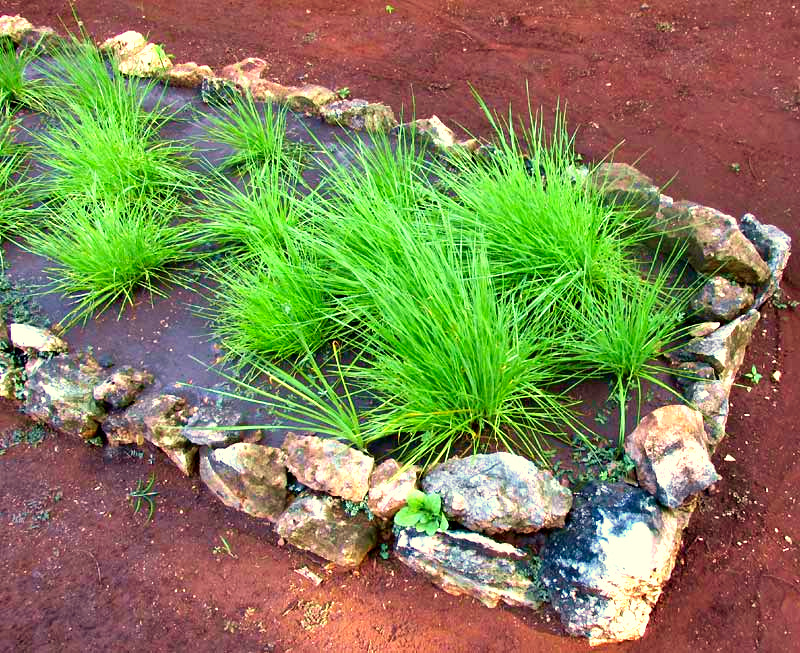
from the October 25, 2015 Newsletter issued from Hacienda Chichen Resort beside Chichén Itzá Ruins, central Yucatán, MÉXICO
MAYA CHIVES -- CEBOLLÍN
Among the traditional Maya crops grown at Hacienda Chichen for use in the kitchen is what the Maya gardeners call Cebollín, which I've always thought of as a kind of chives. In Mexico, several different onion-type plants are called Cebollín. Our local Cebollín is much more robust than the North's chives, and I've often wanted to see some flowers so I could identify the plant's species. However, among the thousands of Cebollines in our garden, normally there's not a single flower. Above,you can see what Maya Cebollín looks like in a traditional Maya, stone-framed "era."
If you separate out an individual stem you see that the leaves are narrowly cylindrical, as they should be as chives. However, the leaves are flattish, while leaves of Northern chives are roundish/cylindrical, and hollow inside. You can see a Maya Chives leaf cross section below:
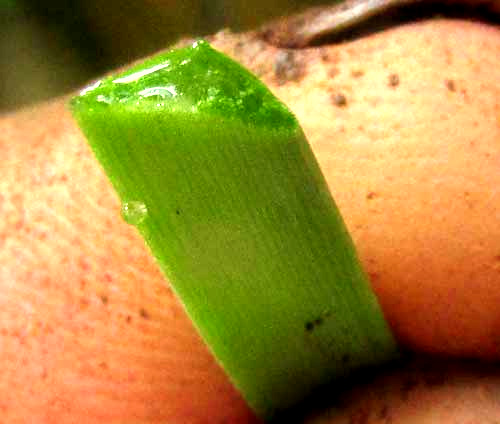
This week one plant among several thousand turned up flowering, so this was my big chance to get an ID. Below, you can see the pretty umbel of white blossoms, typical of onions, or the genus Allium, arising atop a stem and subtended by a semitransparent, onion-skin spathe:
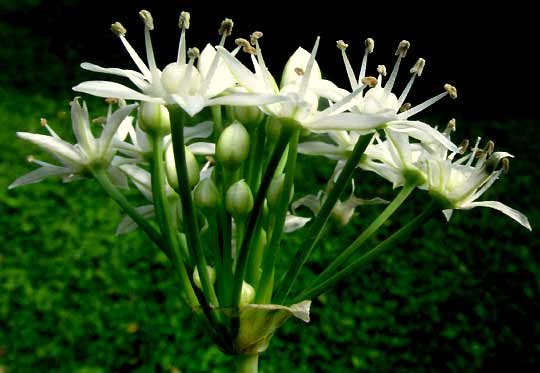
The flowers are pretty enough for a close look, provided below:
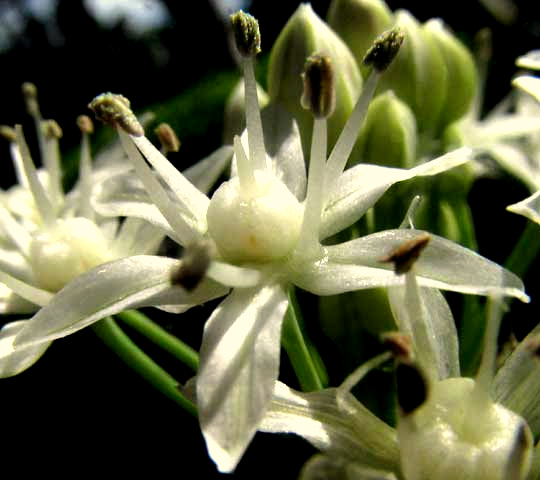
As is perfectly right for the onion genus Allium, there are six stamens arising from the bases of six white, petal-like "tepals," and the spherical ovary is topped with a slender style.
This week not only was a plant flowering, but also another one bore several capsule-type fruits, shown:
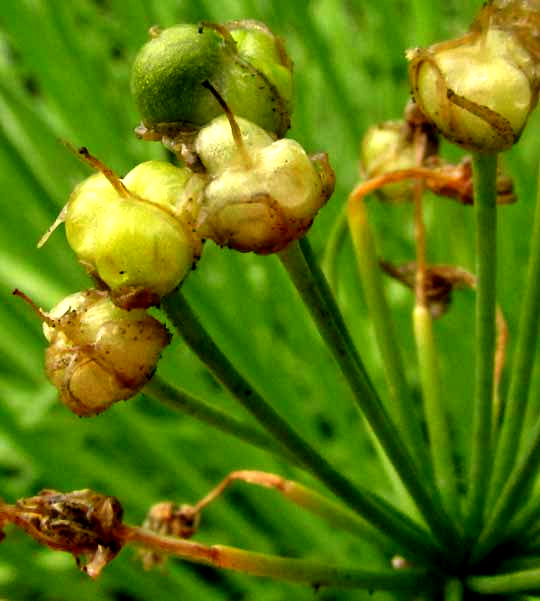
Most of the flowers in this cluster appear to have withered without producing fruits, and the fruits themselves look curiously empty, almost bladder-like. Three of them, however, seemed to contain seeds in at least one of their three chambers, which turned out to be case when I pinched off a couple of fruit tops, shown below:
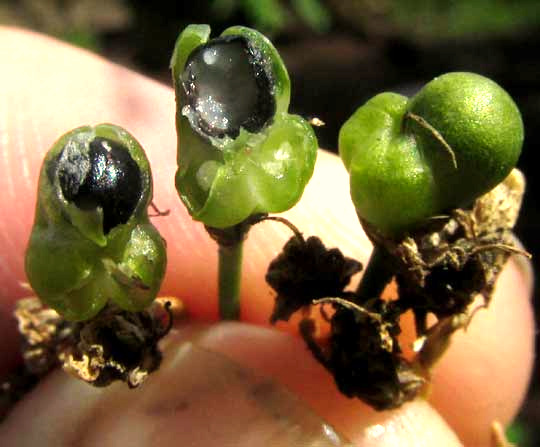
In that picture the center fruit shows a white, aborted ovary at the bottom, left. That flower's seed is broken open revealing white endosperm inside the black seed coat.
So, with all these details surely a good ID should be forthcoming. But, still I've had problems pegging it. Reader Mark in England who knows his garden plants suggested Allium tuberosum, often known in the North as Garlic or Chinese Chives. Our Maya plants are certainly close to that species. A distinguishing feature of Allium tuberosum is that its bulbs arise from underground horizontal rhizomes, and that's the case with our plant. On one of our Maya plants you can see a short section of rhizome exiting the base of a bulb's roots, looking like a brown worm, below:
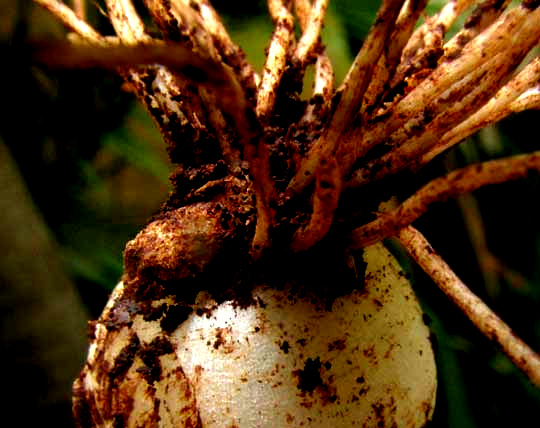
However, we've seen Allium tuberosum in Texas, and those plants were a little different from these Maya ones, especially with the Texas plants having broader, less stiff leaves and not being as densely bushy as the Maya ones. Also, the Texas ones flowered and produced seeds very readily. It seems to me that our present Maya plants are almost Allium tuberosum but not quite. You can compare them with the Texas plants at www.backyardnature.net/n/h/garlchiv.htm.
A webpage in Spanish produced by UADY, the Autonomous University of Yucatán, describing plants found in Maya milpas, or cornfields, mentions Cebollina, which may be the same as our Cebollín, and of all the plants listed on that page, that's the only one identified only to genus level -- as Allium sp.
Since the vast majority of Cebollín plants never produce flowers, and most flowers in an umbel never set fruit, and in those few fruits examined, all contained only one seed instead of the expected three, it may be that Cebollín is a kind of hybrid or mutation with its genes so scrambled by human selective breeding that at this point in its evolutionary history most plants can't reproduce sexually, instead depending on humans to spread around their vegetative clumps, which the Maya clearly have been doing for a long time.
That's not to say that Cebollín is definitely a Maya creation, for we've found crops here introduced from other parts of the world perhaps as early as 500 years ago. During five centuries the Maya have had time to produce their own special crop races and varieties adapted to the Yucatan. That seems to have been the case with the Maya Cucumber we examined at www.backyardnature.net/yucatan/pepino.htm.
So, all this sleuthing just accomplished reaching the same conclusion that we started out with before seeing flowers and fruits: That here the Maya are growing some kind of chives that appear to be unlike other known kinds of chives, and the best technical name we can find for them is ALLIUM sp. And Mark in England has shown us that our plants are very close to Allium tuberosum.